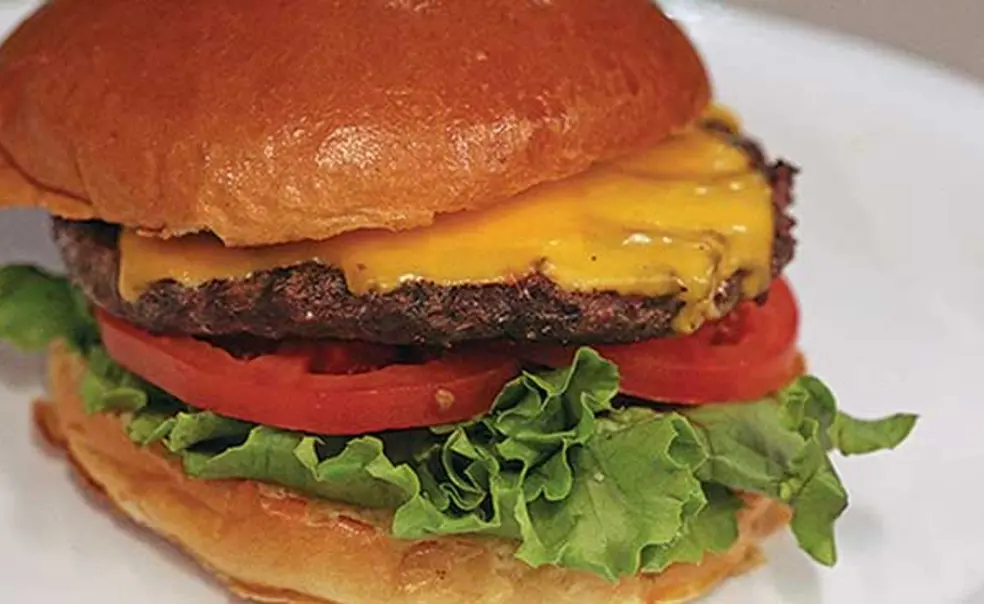The Princeton Crafted Burger: Bye-Bye, All-Beef ... Hello, Sustainability
If you ate a burger on campus during the last year, did you notice anything new? Those juicy grilled patties are a blend of 60 percent grass-fed beef and 40 percent local portobello mushrooms — otherwise known as the Princeton Crafted Burger. All-beef burgers are no longer available on campus.
The change is part of Princeton’s Sustainability Action Plan. “Eating less animal-based protein is often the single most effective thing an individual can do to combat climate change, erosion, and water- and soil-quality degradation,” said Shana Weber, director of the University’s Office of Sustainability.
The burgers, which come from a Trenton supplier, use a proprietary blend “that helps us reduce water use, nitrogen output, land use, and greenhouse-gas emissions,” said Chris Lentz, associate director for campus dining.
Students had mixed views of the new burger. Karissa Lowe ’20 surveyed 202 students for a sustainability course and found that 19 percent liked it, 16 percent disliked it, 31 percent were neutral, and 32 percent said they don’t eat burgers. More than two-thirds said they were not aware that the burger’s mixture had been changed. “I think it tastes similar to a normal all-beef burger,” Lowe said. “It really does have the texture of a burger.” (A PAW writer agreed, adding, “You could have fooled me.”)
Other sustainable food offerings across campus include the introduction of the elote cake (a Mexican dish made with fresh corn, Cotija cheese, chili powder, and a lime-sour cream topping), the meatless Beyond Burger offered at the Frist grill, vegetable paella offered at Forbes College, and the hummus bar at the Center for Jewish Life.












2 Responses
Grady C. Grissom ’84
5 Years AgoBiodiversity in Ranching
I applaud Princeton for creating a Sustainability Action Plan (“Bye-Bye, All-Beef ... Hello, Sustainability,” Jan. 8), but as a rancher I am disappointed by the comment from Director of the Office of Sustainability Shana Weber: “Eating less animal-based protein is often the single most effective thing an individual can do to combat climate change, erosion, and water- and soil-quality degradation.” This broad generalization lumps all animal agriculture into one big bucket.
Worldwide meat-production methods, and associated ecological footprints, vary as widely as the production of a carrot versus cotton candy. Grazing of large herbivores on grasslands throughout the world is a natural product of evolution. All over the world domestic herbivores graze alongside wild herbivores. We spent the last 25 years adapting cattle-grazing protocols on 14,000 acres in Colorado to maximize biodiversity.
The carbon and methane emissions of 30-60 million bison on the Great Plains evolved as part of a carbon/methane cycle. Those bison did not produce carbon or methane; they were part of a food chain that cycled carbon and methane between the soil, plant matter, and the atmosphere. Our cattle fill the same niche. Ms. Weber and anyone at Princeton concerned with livestock and sustainability have an open invitation to visit Rancho Largo Cattle Co. and see regenerative agriculture at work. They can help evaluate hoof impact, manure distribution, plant diversity, invertebrate activity, litter and residual plant cycling, soil structure, and soil biotic activity. We integrate all these metrics to determine grazing protocols. Sustainability can look different on the ground with a producer who draws a livelihood from the land.
Coke Anne Murchison Wilcox ’74
5 Years AgoMore Sustainability Suggestions
I am heartened to read about sustainable food for the students on campus (“Bye-Bye, All-Beef … Hello, Sustainability,” Jan. 8). Delving a bit deeper, I found the environmental studies course to which the PAW article referred.
Having attended our 45th reunion last spring, we were all once again fed the old-fashioned fast-food options, including processed meats and cheeses, tired and aging brown-rimmed lettuces and tomatoes, etc. I then discussed this situation with several of my classmates, some of whom said that I was “preaching to the choir,” while others said that the choices made were based on food costs rather than food values.
This PAW article and the agriculture course both give me hope that fresh and sustainable food options might soon be available for Reunions as well!
My additional suggestion is that the course (or another one) include not just visits to local farms and agricultural facilities, but the development of a greenhouse laboratory on campus for the students to grow all the fresh vegetables that are consumed on campus. Let’s bring a 21st-century food philosophy to Princeton and lead other universities in the nation to do the same!